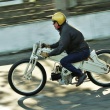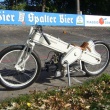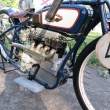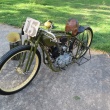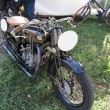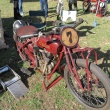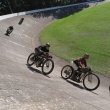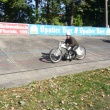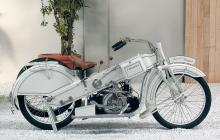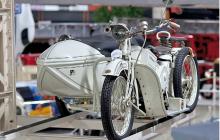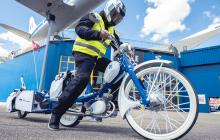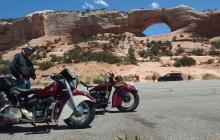A cement track is an oval velodrome for bicycle races and motor-paced races. Motorcycle races also used to take place on cement tracks.
With a Mars 1000 from 1923, we went to a racetrack in Nuremberg called “Reichelsdorfer Keller” (Reicheldorf cellar). Back in the days, motorcycles by the manufacturer Mars in Nuremberg were the measure of all things. Mars factory driver Heinz Wilhelm finished first in the Bavarian Championship in 1921, factory driver Ernst Schütz finished second. Mars machines were also driven in races in 1923. The white Mars is one of the most famous German motorcycles. It is to be mentioned that the machine has a built-in engine from the German manufacturer Maybach who is said to have been involved in the construction of the power transmission as well. Maybach vehicles were built in a way that you did not have to switch gears conventionally but that you could simply drive with a preselector gear box. That is what Maybach vehicles were famous for. The Mars therefore has a system with two drive chains. The gear unit includes a band brake which is why you cannot see any brakes on the wheel hubs of the vehicle.
There is a small group of motorcyclists, many of them have US-American motorcycles, who also drove in so-called “Board Tracks” in the US. Fans of those machines frequently ask for permissions in order to drive on cement tracks.
Our member Udo Dobrzansky brought to my attention that there was a date for the last time anyone could ever drive on the cement track “Reichelsdorfer Keller” in Nuremberg. Investors had bought the historic track and would soon tear it down to build residential buildings instead. That is why it was the last chance for us to drive a Mars racing machine on the exact track where the model had once been so successful. The Mars racing machine was more or less a basic model – a motorcycle in its original form without any knickknack. You barely ever see a Mars nowadays. We have two street models as well as one combination in our museum.
Mike Kron, the famous motorcycle restorer from Klepsau on the river Jagst, restored our Mars 1000 racing machine. The restoration was completed the night before we headed to Nuremberg, so Mike and I were very happy and proud to present our Mars 1000.
The last race on the cement track "Reichelsdorfer Keller" in Nuremberg was accompanied by Board Track, this great video was created:
The event was excellently organised by our friend Thomas Bund. He brought an Excelsior 1000 as well as a very rare 4-cylinder Cleveland. Heavy Harleys and big Indians dominated the field but NSU, Rudge and Vincent were represented as well. The event was very casual. There was a track marshal controlling the entrance to the track and manually signalling slower drivers to let faster drivers pass by. For Mike Kron and me, this was the first time with a motorcycle in a banked turn. The driving experience is very special. You could feel the centrifugal force and all you could see was cement. It takes a lot of courage to drive fast on those tracks. The other drivers were more experienced and they had already driven on other tracks. Udo Dobrzansky had taken his Indian Chout with him, an Indian Scout with a large 1200 Chief engine. The motorcycle was aggressive and brachial. Udo drove fabulously and left his mark as the fastest man on the track.
Unfortunately, there is a third phase in the restoration process after the completion. That is to say that by driving the vehicle, the last details are optimised and the vehicle is only truly completed after months of driving it, after even the tiniest flaws are eliminated. In our case, we found out that the severely nickel-plated gear lever, which you could lock by turning a knob, could not engage properly and this led to us losing propulsion over and over again. We hope to be able to optimise the Mars for the next time on another cement track. For us, it was very exciting and a big deal to bring back the white Mars racing machine to the place where it had once been so successful and to drive it there again, so that, in the end, the “Reichelsdorfer Keller” had the goodbye it deserved.
Standing in an oval with 5 - 6 high-volume machines racing on the track, the banked turns (also called “Nudeltopf” – pasta pot) produce an incredibly intense sound. We were all amazed by the event. A huge thank you goes out to all the organisers.
The stories and reports represent the opinions and perspectives of the respective authors. Please note, especially while reading articles about our events, that binding information (e.g. opening hours, admission fees and programme) is only published on the museum's official website www.technik-museum.de.
Please note that the pictures, texts and videos published here are subject to the copyright of the respective authors and / or the museum and may not be used without permission.
Keep up-to-date with new articles
We recommend to subscribe to the museum’s newsletter via e-mail. At the end of each newsletter, we inform you about new articles so that you will not miss any of them. Alternatively, you can subscribe to an RSS feed:
Subscribe to newsletter RSS-Feed (Reader required)


